Physics:Neutron backscattering
| Science with neutrons |
|---|
 |
| Foundations |
| Neutron scattering |
| Other applications |
| Infrastructure |
| Neutron facilities |
Neutron backscattering is one of several inelastic neutron scattering techniques. Backscattering from monochromator and analyzer crystals is used to achieve an energy resolution on the order of a microelectronvolt (μeV). Neutron backscattering experiments are performed to study atomic or molecular motion on a nanosecond time scale.
History
Neutron backscattering was proposed by Heinz Maier-Leibnitz in 1966,[1] and realized by some of his students in a test setup at the research reactor FRM I in Garching bei München, Germany.[2] Following this successful demonstration of principle, permanent spectrometers were built at Forschungszentrum Jülich and at the Institut Laue-Langevin (ILL). Later instruments brought an extension of the accessible momentum transfer range (IN13 at ILL), the introduction of focussing optics (IN16 at ILL), and a further increase of intensity by a compact design with a phase-space transform chopper (HFBS at NIST, SPHERES at FRM II, IN16B at the Institut Laue-Langevin).
Backscattering spectrometers
Operational backscattering spectrometers at reactors include IN10, IN13, and IN16B at the Institut Laue-Langevin, the High Flux Backscattering Spectrometer (HFBS) at the NIST Center for Neutron Research,[3] the SPHERES instrument of Forschungszentrum Jülich at FRM II[4] and EMU at ANSTO.
Inverse geometry spectrometers
Inverse geometry spectrometers at spallation sources include IRIS and OSIRIS at the ISIS neutron source at Rutherford-Appleton, BASIS at the Spallation Neutron Source, and MARS at the Paul Scherrer Institute
Historic instruments
Historic instruments are the first backscattering spectrometer that was a temporary setup at FRM I and the backscattering spectrometer BSS (also called PI) at the DIDO reactor of the Forschungszentrum Jülich (decommissioned).[5]
References
- ↑ H. Maier-Leibnitz: Grundlagen für die Beurteilung von Intensitäts- und Genauigkeitsfragen bei Neutronenstreumessungen, Nukleonik 8, 61 (1966).
- ↑ Alefeld, B.; Birr, M.; Heidemann, A. (1969). "Ein neues hochauflösendes Neutronenkristallspektrometer und seine Anwendung". Die Naturwissenschaften 56 (8): 410–412. doi:10.1007/BF00593617. ISSN 0028-1042. Bibcode: 1969NW.....56..410A.
- ↑ Meyer, A.; Dimeo, R. M.; Gehring, P. M.; Neumann, D. A. (2003). "The high-flux backscattering spectrometer at the NIST Center for Neutron Research". Review of Scientific Instruments 74 (5): 2759. doi:10.1063/1.1568557. ISSN 0034-6748. Bibcode: 2003RScI...74.2759M.
- ↑ Wuttke, Joachim; Budwig, Alfred; Drochner, Matthias; Kämmerling, Hans; Kayser, Franz-Joseph; Kleines, Harald; Ossovyi, Vladimir; Pardo, Luis Carlos et al. (2012). "SPHERES, Jülich's high-flux neutron backscattering spectrometer at FRM II". Review of Scientific Instruments 83 (7): 075109. doi:10.1063/1.4732806. ISSN 0034-6748. PMID 22852726. Bibcode: 2012RScI...83g5109W.
- ↑ A historical and updated review on neutron backscattering and its applications can be found on WEB-site of Neutron Backscattering Spectroscopy and a more recent version of it at http://www.astrosurf.com/heidemann/bsweb/index.htm/
 |

